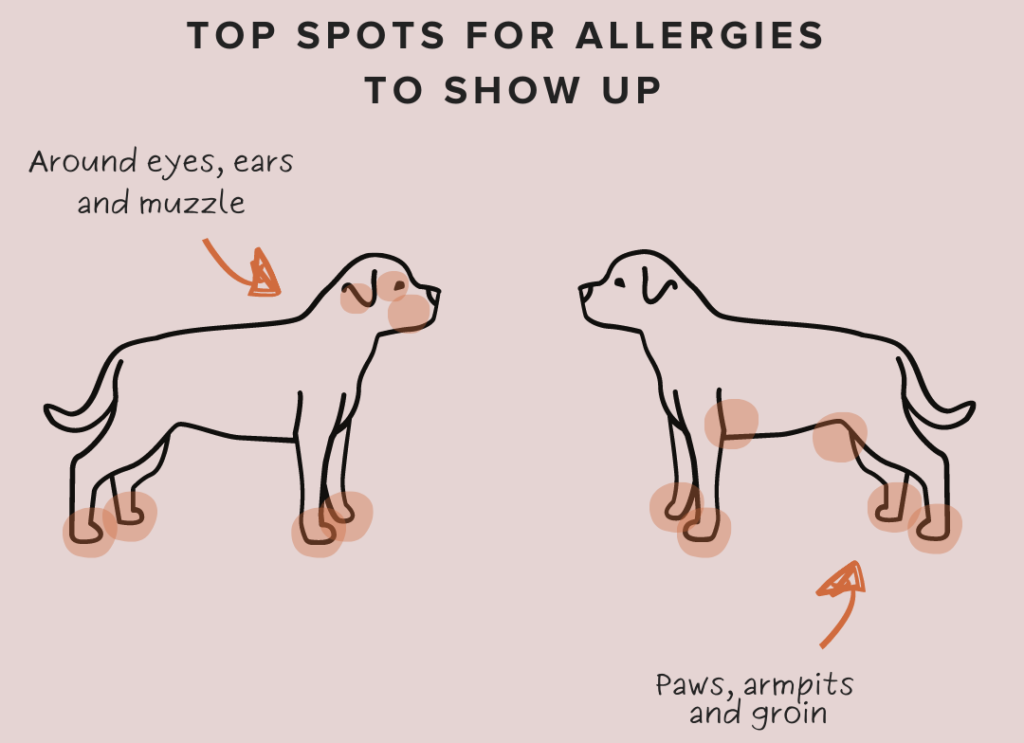The Pet Parent’s Guide to Dog Allergies (Part I)
Dog allergies are paws down our most asked-about topic… and for good reason. It’s hard to watch your dog scratch themselves silly, and even harder not knowing why they’re itchy in the first place. (Is it something they ate? Were they bitten by a bug? Are household cleaning products the culprit?)
To help you scratch the allergy itch, we’ve created a three-part series on allergies in dogs. In this first instalment we’ll cover some of the basics: the different types of dog allergies, common dog allergy triggers, clinical signs of dog allergies, and a step-by-step look at the process of pinpointing pesky allergens.
Types of dog allergies
There are three major types of allergies that can affect your dog:
- Environmental allergies (also known as atopic dermatitis). This is the most common allergy category. Atopic dermatitis can be caused by indoor or outdoor environmental conditions, from feathers and hair to pollen and dust mites.
- Food allergies (also known as cutaneous adverse food reactions). Although food allergies tend to be less common than environmental allergies, reactions to food ingredients can be every bit as severe.
- Flea allergies (also known as flea bite hypersensitivity). These pesky insects get a category all their own because the resulting allergic reaction is exclusive to flea saliva. If you’re in a part of the world with harsh winters you’ll want to take extra precautions against fleas. Yes, you heard that right: flea eggs can still hatch even in the dead of winter. Cold temperatures may slow down the flea life cycle, but they don’t stop fleas from seeking out hosts (like your unwitting pet) as a source of warmth.

What are dog allergies?
Before we can answer this question, we need to back up a step and explain the difference between an allergy and an allergen.
An allergy is an abnormal reaction of the body to the presence of a substance (usually a protein) that would typically be harmless. This substance is called an allergen. An allergic reaction happens when an allergic pet overreacts to an allergen.
What causes this overreaction is where things get complicated. Breed-related sensitivities or pre-dispositions, type of stimulus, and severity of response are just a few of the many factors at play.
Environmental allergens are usually absorbed through pets’ skin, not through inhalation (although both can trigger the same response). Allergens are absorbed through dogs’ footpads simply by stepping on a type of grass, weed, or cleaning agent.
Broadly speaking, some of the most common dog allergy triggers include:
- Feathers
- Dander
- Foods
- Fleas
- Environmental mites
- Household dust mites
- Grass and weed pollen
- Mold
- Tree pollen
Unfortunately, identifying these triggers is easier said than done. Hang tight—we’ll touch on the identification process in a minute.
Similar to dog allergy triggers, there are certain parts of a dog’s body that tend to be more impacted by allergens than others. These include:
- Paws
- Armpits
- Groin
- Ears
- Muzzle
Clinical signs of dog allergies
As you may have guessed, pinpointing allergens is a tricky business. Not only is there significant overlap in the symptoms associated with each of the three types of allergies, pets generally aren’t only allergic to one specific thing, either. What’s worse, often the symptoms that come from subsequent or secondary infections mimic those of an allergic reaction, making it even harder to identify the root cause.
More often than not, the most common sign of an allergic reaction is pruritus, or what the majority of us know as itchiness.

Pruritis may lead to scratching, licking, biting, rubbing, over-grooming, and head shaking. Left untreated, these itchy bad habits can create dog hot spots and other types of superficial skin conditions.
Most allergies, but especially environmental allergies, emerge in young adulthood. Approximately 40% of allergies show up within a dog’s first year.
Sometimes there are clues in a pet’s history that can tip a veterinarian off to whether your dog is suffering from an environmental allergy or a food allergy. These may include:
- Familial history. There is a long list of breeds predisposed to developing environmental allergies. Breeds that tend to top the list are boxers, cocker spaniels, golden retrievers, labrador retrievers, and vizslas. Dogs exhibiting the same or similar symptoms to their parents warrant further investigation.
- Ocular and respiratory problems. Environmental allergies are sometimes associated with eye and breathing issues. Your veterinarian may ask about ocular swelling (periocular dermatitis) and dry eyes, as both of these can cause dogs to inflict self-trauma due to excessive rubbing, blinking, and squinting. Airway inflammation and congestion or difficulties breathing may also be clues that a dog is suffering from allergies.
- Seasonal symptoms. If your dogs’ symptoms only seem to flare up during certain times of the year, seasonal environmental conditions may be to blame. Unfortunately, not all allergic reactions are seasonal—many allergens plague dogs year round. After all, dust is everywhere!
- Digestive symptoms. If your dog is experiencing tummy troubles (diarrhea, excessive gas, more than 2-3 bowel movements per day) this may be an indication of a food allergy, not an environmental allergy. Or, to make things really confusing… a combination of both.
It’s important to keep in mind that the different types of allergies are not mutually exclusive. Some dogs are dealt the difficult hand of both environmental and food allergies, not just one or the other.
Luckily, veterinarians receive extensive training on allergy identification and management, so your family vet will coach you through the process.
How to identify allergies in dogs
If you’re new to the world of allergies in dogs, don’t fret—with the support of a veterinary team, you and your dog are in good hands.
Although allergen identification can be tough, it’s not impossible. The good news is that it’s not always necessary to identify all the allergens involved in order to build an effective treatment plan. Sometimes knowing the major causes of itchiness is enough to provide your dog with much-needed relief and an improved quality of life.

Most veterinarians will start by creating a stepwise plan, gradually moving through each stage to help your dog beat the itch.
Typically, the initial stage involves investigating the major causes of itching that can closely mimic allergies. Most vets will perform skin scrapings to get a close look at your dog’s skin and fur. This helps them rule out parasitic itching from fleas or other ectoparasites. (You’ll recall those pests have an allergy category all their own.) Depending on what your vet thinks or finds, they may prescribe a topical or oral antimicrobial treatment.
Once parasites are off the table, the next step is to deal with any potential or known secondary infections (commonly yeast or bacterial). These may require prescriptions for oral or topical antifungals and/or antibiotics.
If your dog’s allergy symptoms persist year-round, they may be contending with a food allergy. The only way to diagnose a food allergy is an 8-week “elimination diet trial” followed by a diet re-exposure challenge. Doing this with the support of a veterinarian is essential to maximize effectiveness; even the smallest slip-up can negate all your hard work.
If the elimination diet doesn’t yield results, it’s likely your dog is dealing with an environmental allergy… or some combination of both. Many dogs will have to go through a few elimination diets, trialing different novel or hydrolyzed proteins before finding the right one.
EXPERT TIP: Invest in a veterinarian-approved diet. Most pet store diets simply don’t cut it because there is often protein contamination and mislabeling that can trigger an allergic response. Even if you rule out a food allergy, sticking to a vet-prescribed diet is still your best bet for optimal health.
In extreme cases, environmental allergens may be identified through intradermal or blood allergy tests. The results from these tests help veterinary dermatologists create an immunotherapy vaccine to desensitize your pet and kill the itch. Buyer beware: this is an expensive and often lengthy process. Instead, your veterinarian may recommend symptomatic or therapeutic trials with certain regimes that address atopy (cytopoint injections, apoquel oral medication, or regular baths are just a few examples).
If you have a dog with suspected or confirmed allergies, we have good news: Waggle Mail dog subscription boxes are allergy-friendly! Based on the information you share as part of your dog’s intake, we curate vet-exclusive products to accommodate those needs.
Want to be the first to know when the next instalment of our dog allergies series drops? Subscribe to Waggle (e)Mail. We highlight what’s new on the blog and treat our pack members to early access, exclusive offers, and more.

